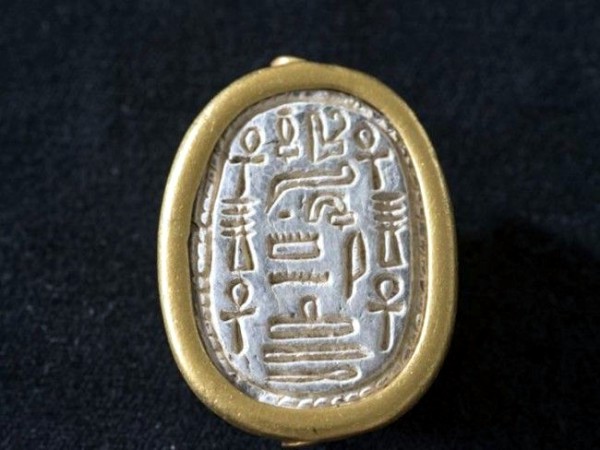“But Moses said to God, ‘Who am I that I should go to Pharaoh and bring the Israelites out of Egypt?’ And God said, ‘I will be with you. And this will be the sign to you that it is I who have sent you: When you have brought the people out of Egypt, you will worship God on this mountain.’” (Exodus 3:11-12)
Less than a week before Passover, the Temple Mount Sifting Project has released news of a rare amulet found in Jerusalem’s Tzurim Valley National Park on the western slope of the Mount of Olives.
The amulet bears the name of the Egyptian ruler Thutmose III, Pharaoh of the Eighteenth Dynasty, who reigned from c. 1479–1426 BC.
Neshama Spielman, 12, uncovered the amulet while sifting through the earth that had been illegally bulldozed and discarded from the Temple Mount grounds by Palestinian workers.
“While I was sifting, I came across a piece of pottery that was different from others I had seen, and I immediately thought that maybe I had found something special,” said 12-year old Spielman in a press release. “It’s amazing to find something thousands of years old from ancient Egypt all the way here in Jerusalem! Celebrating Passover this year is going to be extra meaningful to me.”

Neshama Spielman, 12, uncovered the amulet while sifting through the soil that had been illegally bulldozed off the Temple Mount.
The amulet is designed as a pendant with a loop on top for hanging on a string. The bottom half of the amulet is missing, but the remainder measures 21 mm wide, 4 mm thick and 16 mm long, according to the IAA.
The Temple Mount Sifting Project began in 2004 with the sole mission of sorting and analyzing dirt and debris that had been recklessly removed and discarded from the Temple Mount compound in 1999 by components of the Islamic Waqf, the Jordanian-controlled force in charge of the daily administration of the Temple Mount.
Removing truckloads of earth without the professional oversight and approval of the Israel Antiquities Authority did untold damage to the archaeological history of the Holy Temple of Jerusalem, specifically the area known as Solomon’s Stables.
Despite the destruction of dateable layers of history, archaeologists Zachi Dvira and Dr. Gabriel Barkay launched the Sifting Project in which thousands of young and old volunteers come from around the world every year to salvage what they can from the discarded dirt.

The Temple Mount Sifting Project (formerly known as the Temple Mount Salvage Operation) is an Israeli archaeological project that began in 2005 to recover archaeological artifacts from 400 truckloads of topsoil removed from the Temple Mount by the Islamic Waqf during the construction of the underground el-Marwani Mosque from 1996 to 1999.
While Israelis are remembering the nation’s Exodus from Egypt during this Passover week, the amulet’s timely identification hails back 3,200 years to the reign of Thutmose III, who is described as one of the most important pharaohs of Egypt’s New Kingdom and “the creator of Egypt’s wealth.” (DiscoveringEgypt)
Even though Thutmose III is known to have “referred to himself as ‘the one who has subdued a thousand cities,’ … it is known that for more than 300 years, during the Late Bronze Age, Canaan, and the city state of Jerusalem were under Egyptian dominion, likely explaining the presence of this amulet in Jerusalem,” writes the Sifting Project press release.
“Thutmose III is credited with having transformed Egypt into an international superpower,” writes Breaking Israel News. His unusually long 54-year reign was marked by “a series of military campaigns to re-assert Egypt’s control and to expand its borders,” states The Ohio State University (OSU) Department of History.
“According to the Stele of Thutmose III, over 350 cities fell to the Egyptians under his rule. There is little doubt that his numerous campaigns were extremely successful,” the OSU website states. “He has in fact been referred to as the ‘Napoleon of ancient Egypt’ because of his military expansion.”
Meanwhile, another Egyptian amulet, which was cleaned and catalogued in time for Passover, was discovered at Tel Dor, a principal port city in ancient times.
A birdwatcher happened upon the amulet, which functions as a scarab seal. It had likely become exposed after the winter’s heavy rains.
“The scarab belonged to a very senior figure in the kingdom, probably the viceroy responsible for the royal treasury,” Ayelet Gilboa of the University of Haifa, co-head of excavations at Tel Dor, said in a statement.
“The role of the seal’s owner was similar to that of Joseph in Pharaoh’s kingdom after he interpreted Pharaoh’s dreams,’ she said.
“Since the scarab had rolled off the mound and was not found in its archaeological context, we will probably never really know when and how it got here and where it has been,” Gilboa said. (Ynet)







